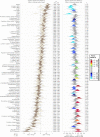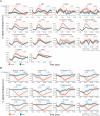Distributed and Multifaceted Effects of Threat and Safety
- PMID: 34942650
- PMCID: PMC8832158
- DOI: 10.1162/jocn_a_01807
Distributed and Multifaceted Effects of Threat and Safety
Abstract
In the present fMRI study, we examined how anxious apprehension is processed in the human brain. A central goal of the study was to test the prediction that a subset of brain regions would exhibit sustained response profiles during threat periods, including the anterior insula, a region implicated in anxiety disorders. A second important goal was to evaluate the responses in the amygdala and the bed nucleus of the stria terminals, regions that have been suggested to be involved in more transient and sustained threat, respectively. A total of 109 participants performed an experiment in which they encountered "threat" or "safe" trials lasting approximately 16 sec. During the former, they experienced zero to three highly unpleasant electrical stimulations, whereas in the latter, they experienced zero to three benign electrical stimulations (not perceived as unpleasant). The timing of the stimulation during trials was randomized, and as some trials contained no stimulation, stimulation delivery was uncertain. We contrasted responses during threat and safe trials that did not contain electrical stimulation, but only the potential that unpleasant (threat) or benign (safe) stimulation could occur. We employed Bayesian multilevel analysis to contrast responses to threat and safe trials in 85 brain regions implicated in threat processing. Our results revealed that the effect of anxious apprehension is distributed across the brain and that the temporal evolution of the responses is quite varied, including more transient and more sustained profiles, as well as signal increases and decreases with threat.
© 2022 Massachusetts Institute of Technology.
Figures














References
-
- Avants, B., Tustison, N., & Song, G. (2009). Advanced normalization tools: V1.0. Insight Journal, 618
-
- Bürkner, P.-C. (2017). brms: An R package for Bayesian multilevel models using Stan. Journal of Statistical Software, 80. 10.18637/jss.v080.i01 - DOI
Publication types
MeSH terms
Grants and funding
LinkOut - more resources
Full Text Sources

